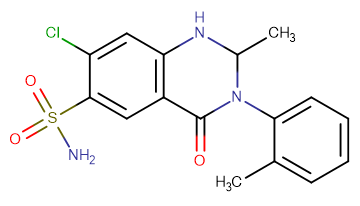
Metolazone
CAS No. 17560-51-9
Metolazone( SR 720-22 )
Catalog No. M12655 CAS No. 17560-51-9
Metolazone(Zaroxolyn) is primarily used to treat congestive heart failure and high blood pressure.
Purity : >98% (HPLC)
 COA
COA
 Datasheet
Datasheet
 HNMR
HNMR
 HPLC
HPLC
 MSDS
MSDS
 Handing Instructions
Handing Instructions
| Size | Price / USD | Stock | Quantity |
| 25MG | 49 | In Stock |


|
| 50MG | 77 | In Stock |


|
| 100MG | Get Quote | In Stock |


|
| 200MG | Get Quote | In Stock |


|
| 500MG | Get Quote | In Stock |


|
| 1G | Get Quote | In Stock |


|
Biological Information
-
Product NameMetolazone
-
NoteResearch use only, not for human use.
-
Brief DescriptionMetolazone(Zaroxolyn) is primarily used to treat congestive heart failure and high blood pressure.
-
DescriptionMetolazone(Zaroxolyn) is primarily used to treat congestive heart failure and high blood pressure.(In Vitro):Metolazone (SR-720-22) is a thiazide-like diuretic marketed under the brand names Zytanix from Zydus Cadila, Zaroxolyn, and Mykrox. It is primarily used to treat congestive heart failure and high blood pressure. Metolazone indirectly decreases the amount of water reabsorbed into the bloodstream by the kidney, so that blood volume decreases and urine volume increases. This lowers blood pressure and prevents excess fluid accumulation in heart failure. Metolazone is sometimes used together with loop diuretics such as furosemide or bumetanide, but these highly effective combinations can lead to dehydration and electrolyte abnormalities. Metolazone and the other thiazide diuretics inhibit the function of the sodium-chloride symporter, preventing sodium and chloride, and therefore water too, from leaving the lumen to enter the tubule cell. As a result, water remains in the lumen and is excreted as urine, instead of being reabsorbed into the bloodstream. Since most of the sodium in the lumen has already been reabsorbed by the time the filtrate reaches the distal convoluted tubule, thiazide diuretics have limited effects on water balance and on electrolyte levels. Nevertheless, they can be associated with low sodium levels, volume depletion, and low blood pressure, among other adverse effects.
-
In Vitro——
-
In Vivo——
-
SynonymsSR 720-22
-
PathwayOthers
-
TargetOther Targets
-
RecptorNa+/Cl-symporter
-
Research AreaCardiovascular Disease
-
Indication——
Chemical Information
-
CAS Number17560-51-9
-
Formula Weight365.83
-
Molecular FormulaC16H16ClN3O3S
-
Purity>98% (HPLC)
-
SolubilityEthanol: 8 mg/mL (21.86 mM); DMSO: 73 mg/mL (199.54 mM)
-
SMILESO=S(C1=CC2=C(NC(C)N(C3=CC=CC=C3C)C2=O)C=C1Cl)(N)=O
-
Chemical Name7-chloro-2-methyl-3-(2-methylphenyl)-4-oxo-1,2-dihydroquinazoline-6-sulfonamide
Shipping & Storage Information
-
Storage(-20℃)
-
ShippingWith Ice Pack
-
Stability≥ 2 years
Reference
1.Rosenberg J, et al. Cardiovasc Drugs Ther. 2005 Aug;19(4):301-6.
molnova catalog



related products
-
Lanreotide acetate
Lanreotide acetate (BIM 23014 acetate) has been used as an inhibitor to test the variability of h2s regulation in wild-type mice with growth hormone/thyroid hormone signal transduction.
-
Engeletin
Engeletin possesses potent inhibition of PGE2 release with IC5 values of 19.6 μg/ml.
-
Resorcin monoacetate
Resorcinol monoacetate is an antiseptic and a disinfectant, is a chemical intermediate for the production of many other pharmaceuticals, and can be used to treat acne, seborrheic dermatitis, eczema, psoriasis, and other skin disorders.



 Cart
Cart
 sales@molnova.com
sales@molnova.com


